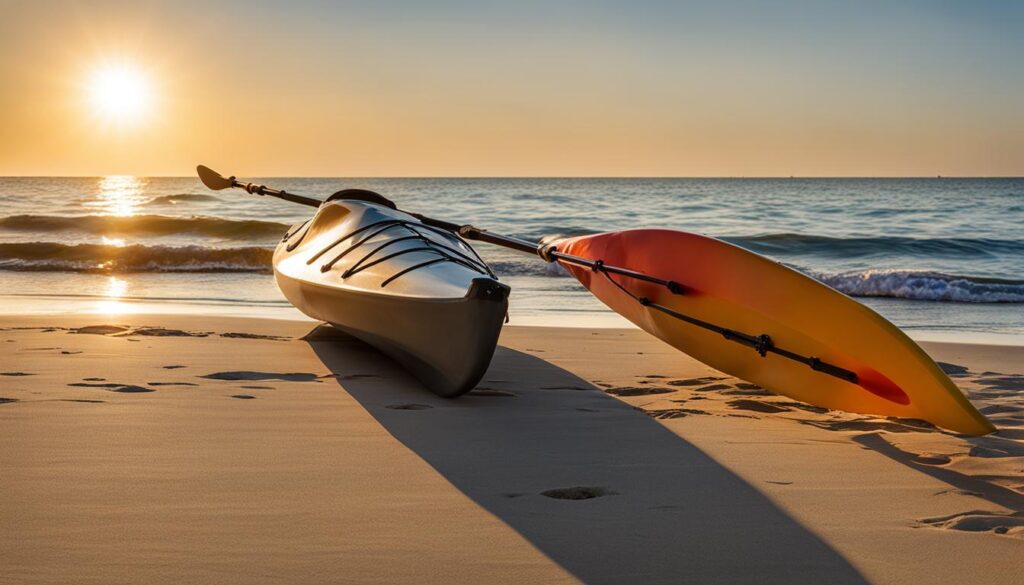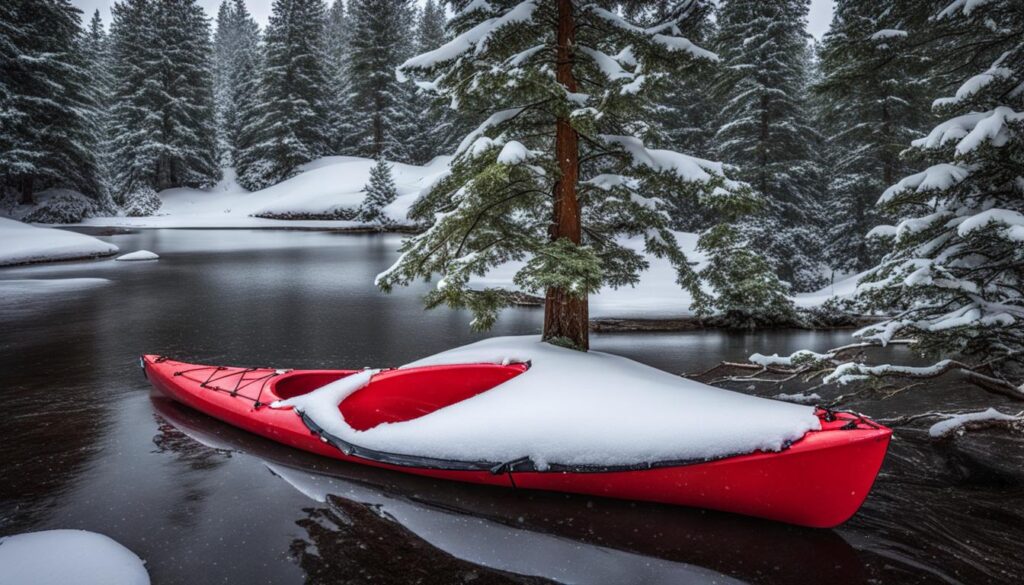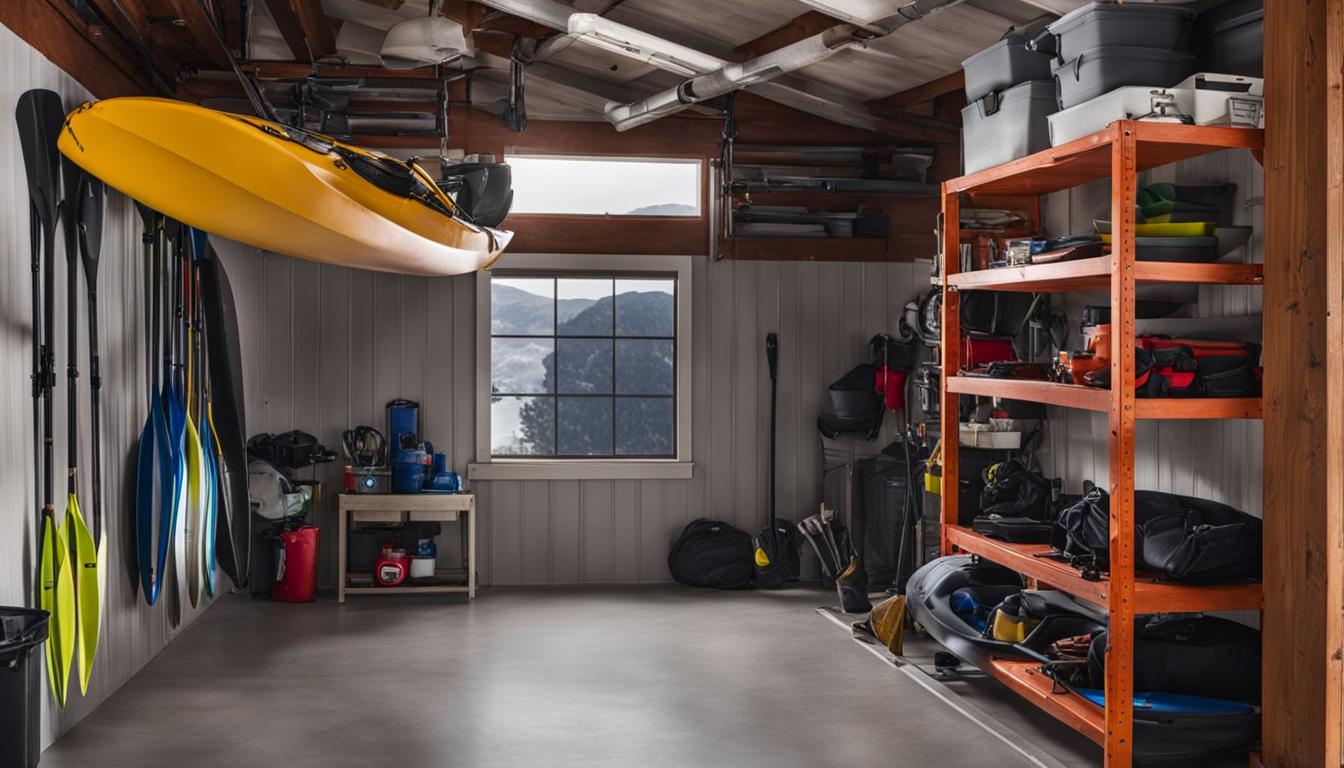Proper care and maintenance are essential to keep your recreational kayak in top condition and ensure its longevity. By following a few simple steps, you can protect your kayak from damage and enjoy many years of thrilling adventures on the water. In this section, we’ll provide you with valuable tips on kayak storage and maintenance, as well as long-term storage ideas for when you’re not out paddling.
Key Takeaways
- Proper storage is crucial for maintaining the condition of your kayak and preserving its lifespan.
- Consider the best storage location for your kayak, whether it’s indoors or outdoors, and protect it from sunlight and moisture.
- Utilize storage racks or suspension systems to keep your kayak safe and prevent deformation.
- Protect your kayak from potential damage by using UV protection products, avoiding pressure points, and considering theft protection measures.
- Perform regular maintenance tasks to keep your kayak clean and in optimal performance, and remember to winterize it for cold temperatures.
Where to Store Your Kayak
Whether you have limited storage space or a spacious garage, finding the right place to store your kayak is essential for its longevity. Indoor storage offers protection from the elements, while outdoor storage requires measures to protect your kayak from sunlight and moisture.
Indoor Kayak Storage
If you have enough space indoors, storing your kayak inside is a great option. It provides protection from the elements, prevents exposure to direct sunlight, and reduces the risk of damage from extreme temperatures. Consider the following tips for indoor kayak storage:
- Choose a spot that is clean, dry, and away from direct sunlight.
- Use a kayak storage rack or wall-mounted hooks to keep your kayak off the ground and prevent any potential pressure points.
- Place foam padding or towels in contact points to further protect your kayak from scratches.
- Ensure there is enough space around the kayak to prevent accidental bumps or knocks.
Outdoor Kayak Storage
If indoor storage is not an option, storing your kayak outdoors is still feasible with proper precautions. Here are some tips to protect your kayak when storing it outside:
- Find a shaded area or use a UV-resistant cover to shield your kayak from prolonged exposure to sunlight, which can cause fading and degradation of materials.
- Elevate your kayak off the ground using a sturdy kayak storage rack or stand to prevent damage from moisture, insects, and rodents.
- Choose a spot with good airflow to minimize condensation and reduce the risk of mold or mildew growth.
- Regularly inspect your kayak for any signs of damage or wear and address any issues promptly.
Remember, regardless of whether your kayak is stored indoors or outdoors, regularly inspecting and cleaning it is important for its maintenance and longevity. By taking the necessary precautions, you can ensure that your kayak remains in excellent condition and ready for your next adventure.
How to Store Your Kayak
Properly storing your kayak is vital for maintaining its shape and preventing damage. Whether you have limited space or ample room, there are various storage methods you can employ to keep your kayak safe and secure.
Racks for Kayak Storage
Kayak storage racks are a popular choice for many kayakers. These racks can be installed in your garage, shed, or other storage areas, providing a dedicated space to keep your kayak off the ground and protected. There are different types of racks available, including wall-mounted racks, freestanding racks, and ceiling-mounted hoists, each offering its own advantages.
For example, wall-mounted racks are an excellent option if you have limited floor space. They allow you to store your kayak vertically against the wall, freeing up valuable floor space. Freestanding racks, on the other hand, provide the flexibility to move your kayak around as needed, making them ideal for outdoor use. Ceiling-mounted hoists are a great choice if you want to suspend your kayak from the ceiling, keeping it out of the way and maximizing your storage area.
Cleaning and Preservation
Prior to storing your kayak, it’s important to ensure it is clean and dry. Use a mild detergent and water to gently clean the hull and remove any dirt or debris. Avoid using harsh chemicals or abrasive cleaners as they can damage the kayak’s surface. Once clean, allow the kayak to thoroughly dry before storing it to prevent the growth of mold or mildew.
Additionally, consider applying a protective coating or wax to the kayak’s surface to safeguard it from UV rays and other environmental factors. This will help extend the lifespan of your kayak and keep it looking its best for years to come.
Weight Distribution
Proper weight distribution is crucial when storing your kayak. Avoid placing excessive weight on one side, as this can cause the kayak to warp or deform over time. Instead, distribute the weight evenly by using kayak cradles or foam padding to support the hull along its length.
By following these storage tips, you can ensure that your kayak remains in excellent condition and ready for your next adventure on the water.
| Storage Method | Advantages |
|---|---|
| Wall-mounted racks | Saves floor space |
| Freestanding racks | Portable and versatile |
| Ceiling-mounted hoists | Maximizes storage area |
Protecting Your Kayak from Damage
Properly protecting your kayak is essential for ensuring its longevity and avoiding potential damage. By taking steps to shield your kayak from UV rays, avoiding pressure points, and implementing theft protection measures, you can keep your kayak in excellent condition for years to come.
UV Protection for Kayaks
UV rays from the sun can cause significant damage to your kayak’s hull and fade its color over time. To protect your kayak from UV rays, consider applying a UV protectant spray or wax specifically designed for watercraft. These products provide a barrier against harmful rays and help prevent fading and cracking. Remember to reapply the UV protectant regularly, especially after prolonged exposure to sunlight.
Avoiding Pressure Points
When storing your kayak, it’s important to avoid placing it on surfaces that create pressure points and can lead to deformation. Hard surfaces like concrete or metal can cause stress on specific areas of your kayak’s hull, compromising its integrity. Instead, use padded storage racks or cradles that distribute the weight evenly and support the kayak without creating pressure points. By doing so, you can maintain the shape of your kayak and prevent potential damage.
Theft Protection for Kayaks
Protecting your kayak from theft is essential, especially if you store it outdoors or in a location exposed to public access. To deter thieves, consider investing in a quality kayak lock or a security system specifically designed for watercraft. Secure your kayak to a fixed object using a strong cable or chain, and ensure that the lock is visible to discourage potential theft. Additionally, consider storing your kayak in a locked shed or garage when not in use, further reducing the risk of theft.

| UV Protection Products | Avoiding Pressure Points | Theft Protection Measures |
|---|---|---|
| – UV protectant sprays | – Padded storage racks | – Quality kayak locks |
| – UV protectant waxes | – Cradles with even weight distribution | – Security systems for watercraft |
| – Regular reapplication | – Avoid storing on hard surfaces | – Secure kayak with cables or chains |
Seasonal Kayak Maintenance Tips
Proper maintenance is essential for keeping your recreational kayak in optimal condition all year round. By following these seasonal maintenance tips, you can ensure that your kayak remains in top shape and ready for your next adventure.
1. Cleaning and Preserving Your Kayak
Regular cleaning is crucial for removing dirt, grime, and saltwater residue from your kayak. Use a mild soap or a dedicated kayak cleaner and a soft sponge or cloth to gently scrub the surface. Rinse thoroughly with fresh water to remove any remaining cleaning solution.
Once your kayak is clean and dry, consider applying a protective layer to preserve its finish and protect against UV damage. There are specialized kayak protectants available, or you can use a high-quality UV-resistant wax. Apply the protective product according to the manufacturer’s instructions, focusing on exposed areas like the deck and hull.
2. Winterizing Your Recreational Kayak
If you live in an area with cold winters, it’s important to take extra steps to protect your kayak from freezing temperatures. Start by thoroughly cleaning and drying your kayak as mentioned earlier.
Next, remove any detachable parts, such as seats or storage compartments, and store them indoors in a dry and temperature-controlled space. This will prevent them from being damaged by extreme cold or moisture.
To prevent the hull from cracking due to freezing water, it’s essential to store your kayak upside down. This will allow any water to drain out and minimize the risk of damage. Additionally, consider covering your kayak with a breathable storage cover to protect it from dust and any potential impacts.
3. Kayak Hull Maintenance
Keeping the hull of your kayak in good condition is vital for optimal performance on the water. Regularly inspect the hull for any signs of damage, such as cracks or scratches. If you notice any issues, address them promptly to prevent further damage.
To maintain the smoothness of the hull and improve performance, consider applying a high-quality kayak hull polish or wax. This will not only make your kayak glide through the water more efficiently but also provide additional protection against scratches and UV damage.
Remember, proper maintenance of your recreational kayak will not only prolong its lifespan but also enhance your paddling experience. By following these seasonal maintenance tips and regularly inspecting your kayak, you can ensure that it remains in excellent condition for many seasons of enjoyment.

Conclusion
Proper maintenance and storage are crucial for keeping your recreational kayak in excellent condition for years to come. By following the tips provided in this article, you can ensure that your kayak remains in peak performance for all your aquatic adventures.
Regular upkeep and repairs are essential to extend the lifespan of your kayak. Perform routine inspections and address any issues promptly to prevent further damage. Whether it’s fixing a small crack or replacing worn-out parts, DIY kayak maintenance can save you time and money.
When it comes to long-term storage ideas, consider your space and budget. If you have ample room, invest in a kayak rack or suspension system to keep your kayak safe and protected. Alternatively, you can store your kayak in a secure storage facility to shield it from the elements and potential theft.
Remember, taking care of your kayak not only preserves its value but also enhances your overall paddling experience. So, make sure to maintain and store your kayak properly, take it out for regular adventures, and enjoy the wonders that the water has to offer!
FAQ
What is the best way to store my recreational kayak?
Proper storage for your kayak depends on available space. Indoor storage in a garage or shed is ideal, but if that’s not possible, consider outdoor storage with protective measures against sunlight, moisture, and extreme temperatures.
How can I protect my kayak from damage when storing it outdoors?
To protect your kayak from the elements, use a UV protection product to shield it from sunlight. Additionally, avoid placing pressure points on the kayak and consider using theft protection measures.
What are some recommended kayak storage methods?
Racks and suspension systems are popular storage methods that keep your kayak off the ground and prevent deformation. Be sure to distribute the weight evenly and clean your kayak before storage.
How should I clean and preserve my kayak?
Regular cleaning with mild soap and water will help maintain your kayak’s condition. Applying a UV protectant and storing it away from direct sunlight will also help preserve its longevity.
How should I winterize my recreational kayak?
To protect your kayak during the winter months, clean it thoroughly, remove any accessories, and store it in a dry place away from extreme temperatures. Consider using a kayak cover for added protection.
How can I ensure optimal performance of my kayak’s hull?
Regularly inspect and maintain the hull of your kayak. Check for any damage or leaks and repair them promptly. Avoid dragging the kayak on rough surfaces to prevent unnecessary wear and tear.





